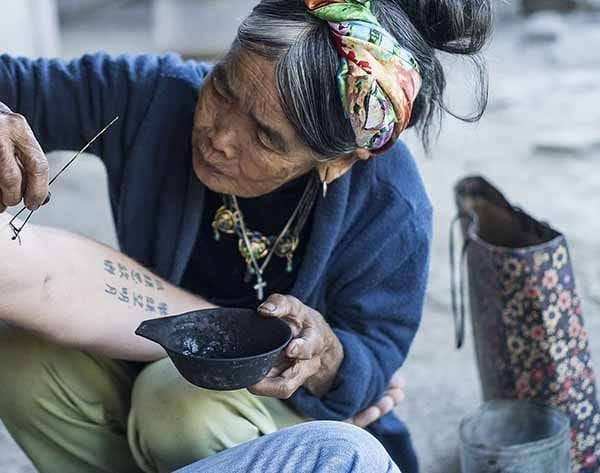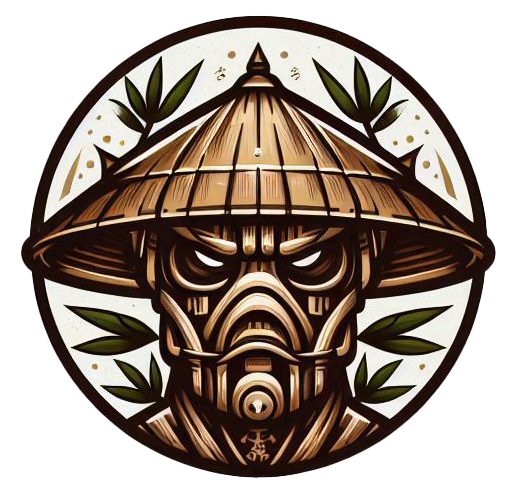Traditional Thai Tattoo vs Bamboo Tattoo (non-existent in Thai Culture)

Thailand's Traditional Thai Tattoo are not called Bamboo Tattoo or use Bamboo Needles. The confusion has built a modern Tourist driven Gimmick now promoted by Thailand Tattoo Shops and Bloggers
In recent years, the term “bamboo tattoo” has gained popularity among travelers and tattoo enthusiasts seeking a mystical and authentic experience in Southeast Asia, particularly in Thailand.
Promoted as an ancient Thai technique using bamboo sticks, this form of tattooing is often glamorized by travel bloggers, and tattoo studios websites. But here’s the truth: Thailand bamboo tattoos, as they popularly known in the West, do not exist in traditional Thai culture (4) (3).
This blog post aims to debunk the widespread myth of the so-called bamboo tattoo, shed light on the true history and practice of traditional Thai tattooing, and clarify the origins of this misnomer.
The Origin of the Thailand Bamboo Tattoo Myth
The idea of Thailand bamboo tattoo likely originated from a simplified and mistaken interpretation of the traditional hand-poked tattooing method used in Southeast Asia. The Philippines used Bamboo in the Batok method of creating tattoos, along with the traditional Japanese style of Irezumi which is applied using a hand poke method with a stick.
When western media reported on Angelina Jolie’s (and other celebrities) Traditional Thai Tattoo (Sak Yant) they made the incorrect assumption that Thailands Traditional Thai Tattoos used bamboo; due to the similarities of the hand poked application of other cultures. This myth (of the involvement of Bamboo) has been repeated by travel bloggers and social media posts by tourist enough to get a Tourist Bamboo Tattoo while on holiday in Thailand confusing it as the same thing as a traditional Thai tattoo.
Western tourists began referring to the method as “bamboo tattooing” because it involves a rod-like instrument that resembles a bamboo stick. Over time, this label stuck, and many tattoo studios, particularly those catering to foreign clientele adopted the term for marketing purposes. (15)
However, the traditional Thai tattooing tool, known as a “mai sak” (ไม้สัก), is not made of bamboo. Instead, it is typically crafted from metal or wood and finished with a fine steel needle tip.(6) (7). The use of bamboo needle would be impractical due to its porous structure and inability to hold ink, and lack of durability and strength when cut to a point.
Traditional Thai Tattoo vs Bamboo Tattoo: Regional Confusion of Neighboring Practices
Another reason for the persistence of the bamboo tattoo myth is the conflation of different regional tattooing traditions. In Cambodia and Laos, hand-poked tattooing methods exist and sometimes use bamboo-like tools, but these practices are distinct from Thailand’s Traditional Thai Tattoo or Sak Yant.
Additionally, hand-tap and stick-and-poke methods from other parts of Asia and the Pacific Islands may use bamboo tools, contributing to the generalization. However, attributing these tools and methods to Thailand is inaccurate and oversimplifies the rich diversity of tattooing traditions across Asia.
The Real Traditional Thai Tattoo - The Sak Yant
The authentic form of traditional Thai tattooing is called Sak Yant (สักยันต์), which translates to “tattoo yantra.”(9). These tattoos are deeply spiritual, often performed by Buddhist monks or Ajarns (respected spiritual tattoo masters). The designs are based on sacred geometry, ancient scripts, and spiritual beliefs, intended to provide protection, strength, and blessings.
Sak Yant is not merely a form of body art but a ceremonial and spiritual practice. The process typically includes chanting, offerings, and specific rituals that connect the recipient to the spiritual realm. This tradition dates back centuries and is rooted in Brahmanism and Theravada Buddhism.
Remedies for Thailand Bamboo Tattoo Tourist Scam
The Influence of Western Tourism on Counterfeit Traditional Thai Tattoos
Tourism has played a significant role in the spread of the Thailand bamboo tattoo myth (15) (7). Many Thai tattoo studios have embraced the term to attract foreign customers who are enchanted by the allure of an “ancient bamboo tattoo technique.”
While this might be an effective marketing strategy, it contributes to cultural misrepresentation. Mislabeling the art of Sak Yant as a bamboo tattoo not only distorts the truth but also diminishes the sacred and spiritual significance of the practice. A fact known and accepted by the vast majority of Thai peoples basic knowledge. (4) (3)
Some studios even go so far as to craft rods out of bamboo for aesthetic purposes when serving tourists, further reinforcing the myth. However, these are typically modified with metal needle tips, making them fundamentally different from what most imagine when they hear “bamboo tattoo.”
The Importance of Cultural Accuracy
Understanding the true origins and practices of Sak Yant is crucial for cultural preservation and respectful engagement. When tourists refer to Sak Yant as bamboo tattoos, they unknowingly perpetuate a false narrative that undermines the depth and history of the tradition.
If you’re interested in receiving a Sak Yant tattoo, it is essential to do your research. Seek out a reputable Ajarn or temple, understand the spiritual commitment involved, and approach the experience with reverence rather than as a trendy activity.
How to Talk About Traditional Thai Tattoo Sak Yant Correctly
Instead of using the term “bamboo tattoo,” which is misleading, refer to the practice by its proper name: Sak Yant. If necessary, you can describe it as a traditional Thai hand-poked tattoo performed with a metal rod.
Educating others and correcting misconceptions helps preserve the integrity of the practice and honors the cultural heritage it represents. Remember that the words we choose shape perceptions.
Conclusion
The idea of the bamboo tattoo in Thailand is a romanticized myth born from tourism, marketing, and cultural simplification. Traditional Thai tattooing, or Sak Yant, is a sacred spiritual practice performed with precision metal tools, not bamboo sticks.
By understanding and respecting the true origins and meanings of Sak Yant, we can appreciate it not just as body art but as a profound cultural and spiritual expression. Let us move beyond the myths and embrace the reality with the reverence it deserves.
So next time you hear someone mention getting a bamboo tattoo in Thailand, you’ll know the truth: it’s not bamboo, and it’s not just a tattoo.
Read More Articles
- All
- Bamboo Tattoo
- Sak Yant Tattoo
- Tattoo Shop

What is a Bamboo Tattoo? What is a Bamboo Tattoo? | Meaning of Bamboo Tattoos Thailands Bamboo Tattoos are a...

Why you don’t get a Tattoo Artist Sak Yant Why you don’t get a Tattoo Artist Sak Yant Bamboo Needle...

Biggest Thailand Tourist Scam – Fake Sak Yant Bamboo Tattoo While not that well known or at all reported, one...

What to Do After Getting a Fake Sak Yant Receiving a Sak Yant tattoo is often considered a sacred and...

How to Avoid getting Fake Sak Yants Tattoo Shops in Thailand and regular Tattoo Artists can’t do real Sak Yant...

Thailands Bamboo Tattoo History – A modern gimmick for Tourists The History of Bamboo Tattoo in Thailand. Historical and Academic...
Academic and Historical References
(1). Thai Tattoos, the symbolic lines of faith National Geographic. Nov 4 2020. https://ngthai.com/cultures/31619/thai-traditional-tattoos
(2) Why you don’t Get a Bamboo Tattoo at a Tattoo Shop sakyantchiangmai.com Oct 2022 https://sakyantchiangmai.com/sak-yant-bamboo-tattoo/
(3) Study of Thai and Japanese Tattoo. 1996 Nantchaya Mahakhan Burapha University, Faculty of Humanities and Social Sciences https://buuir.buu.ac.th/xmlui/handle/1234567890/549
(4) Communication and Perception of the Meaning of ‘Tattoos’ in Contemporary Thai Society’, Faculty of Communication Arts, Chulalongkorn University, by Suksan Kamolsantiroj, 2005 https://cuir.car.chula.ac.th/handle/123456789/8025
(5) What is a Bamboo Tattoo. Sak Yant Chiang Mai 2023 https://sakyantchiangmai.com/bamboo-tattoo-thailand/
(6) Tattoo Culture in Lana Sept 6 2022. Princess Maha Chakri Sirindhorn Anthropology Centre. Phudech Saensa https://www.sac.or.th/portal/th/article/detail/371
(7). Sak Yant tattooing as Thai soft power. Department of Public Administration Faculty of Political Science Ramkhamhaeng University. Krissada Promvek. And Prachaya Chumnaseaw 2024. http://www.hurujournal.ru.ac.th/journals/35_1719810573.pdf
(8) Bamboo Tattoo Bangkok. Sak Yant Bangkok 2024. https://sakyant-bangkok.com/bamboo-tattoo-bangkok/
(9) What is a Sak Yant Tattoo. 2022 Sak Yant Chiang Mai https://sakyantchiangmai.com/what-is-a-sak-yant-tattoo/
(10) Pansa Khrueaklai and Noppadol Inchan, 2002, p. 73)
(11) Chuanphit Naphatasaai (editor), Dhammatharo Achariyanuson, (cited), page 49.
(12) Book The Brave One. (Phra Athit Attharo and Phra Maha Wirot , 2566)
(13) Tourist Bamboo Tattoo vs Real Sak Yant. Youtube Video https://www.youtube.com/watch?v=-HogMIhYYz8
(14) The Story of the Bamboo Tattoo Needle. Thai Tattoo Chiang Mai. https://thaitattoochiangmai.com/2016/08/28/bamboo-sak-yant-needles/
(15) Thailand To Tattoo Tourists: Think Before You Ink NPR Radio June 20, 2011

